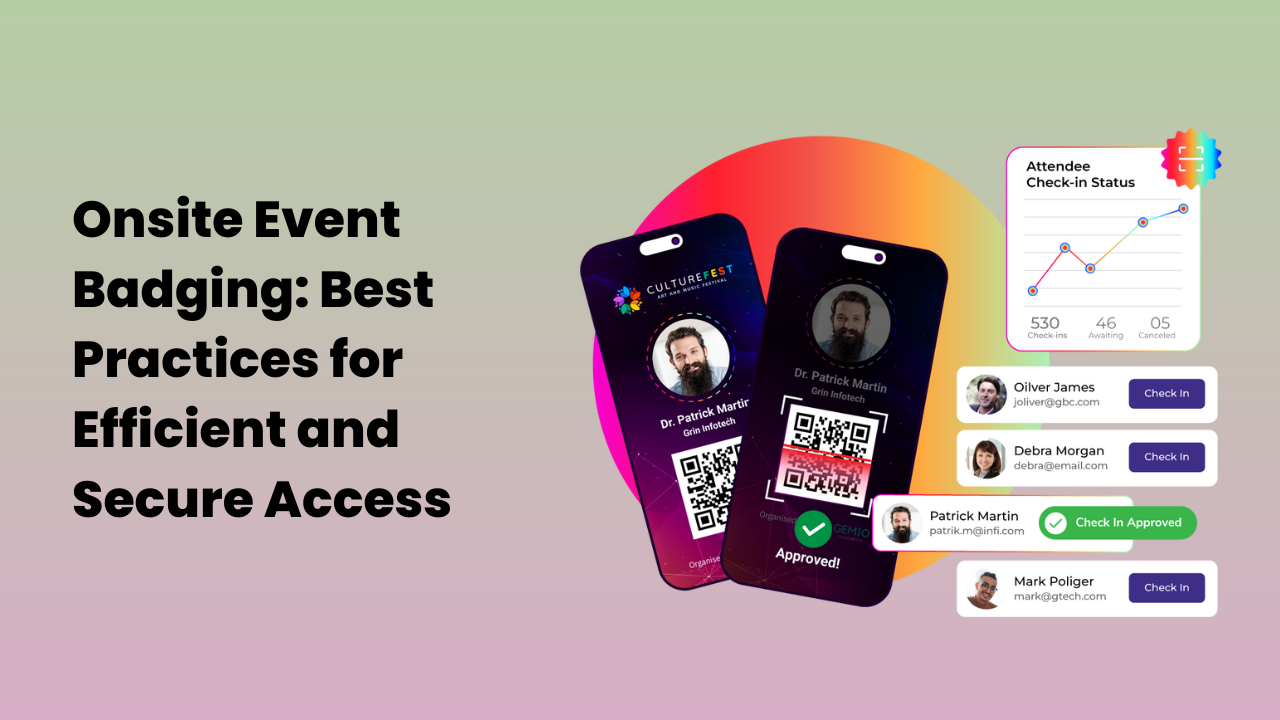Onsite Event Badging: Best Practices for Efficient and Secure Access

Badging is an important step in the world of events that people often don’t put too much thought into. However, onsite event badging is one of the most important components of achieving a successful event. Efficient and safe event check-in and badging could reduce entry times, assist with security, and make the attendee experience flow. Whether it’s corporate conferences, festivals, or trade shows, how you handle badging will define your guests’ first impressions.
In this article, we’ll dive into the best practices for onsite event badging and how to ensure both efficiency and security without sacrificing ease of use for attendees.
Why Onsite Event Badging Matters
Onsite event badging is more than just handing out name tags or wristbands. It is access control management, support for the brand, and efficient entry that can make or break a smooth ride through the rest of the event. Good onsite event check-in and badging will either make visitors feel welcome and safe or make them spend hours standing in lines and confused lines.
Indeed, it is a time when many experiences are shifting toward cashless payments, mobile apps, and RFID wristbands. And yet they still are an event staple for a reason. Badges offer a tangible form of identification that helps event staff, security teams, and other attendees quickly and easily recognize who belongs where. It can be very crucial at larger or more complex events.
Best Practices for Efficient Onsite Event Badging
1. Pre-Event Registration and Badge Printing
A smooth onsite badging experience begins long before attendees arrive at the venue. In fact, encouraging as many attendees as possible to pre-register online and offering them the ability to input their details in advance really saves time on the day of the event. Its data can be used to pre-print badges.
Options include mailing badges in advance to participants or making them easy to print at the show. Pre-printed badges eliminate the problem of needing to organize people on arrival: those who attend will be equipped and up and running within an hour of arriving. For pre-registrants, it is extremely important to have streamlined onsite printing capabilities for those who don’t pre-register.
2. Self-Service Kiosks
One of the best ways to avoid long lines in your event is to present self-service kiosks. With kiosks, attendees will be able to check in, print their badges, and even acquire any necessary materials. In bigger events, kiosks can strategically avoid significant congestion in one central location.
Another advantage of self-service kiosks is that they can proceed at their own pace. If there is an attendee who needs a few minutes to find registration information, they’re not holding up the line.
3. RFID and NFC Badging
Radio Frequency Identification and Near Field Communication technologies are the new cornerstones of event check-in and badging solutions. These technologies turn badges into much more than name tags. They become tools for access to sessions, tracking movement, or even making purchases.
Self-service kiosks are located at every exit and allow attendees to scan their RFID or NFC badges to enter secure areas like VIP lounges or break-out rooms. Thus, there is no need to have a staff to manually check each badge. This would ensure a quick entry process.
These badges can also be used with cashless payment systems in order that attendees may buy food, drinks, or any merchandise on-site without the necessity of bringing cash or credit cards.
4. Clear Badge Design
An often-overlooked, yet vital, aspect of onsite event badging is actually in the design of the badge itself. Badges should be easy to read from a distance and must clearly display key information, including name, company, and access level. For larger events, color-coded badges by access type (VIP, speaker, exhibitor, etc) help the staff quickly determine where someone has the authority to go.
Badges also can be used as promotional items. Printing the logo of the event, the sponsors, and social media handles can help reinforce branding and invite attendees to create buzz about the event online. However, don’t crowd it to the point that it looks messy with too much going on. The important information that stands out should be the names and titles.
5. Onsite Badge Printing Solutions
Even with the best-laid plans, there will always be a percentage of attendees coming without their proper event registration or requiring last-minute changes to their badges. That is where a sound onsite badge printing solution becomes critical.
Use high-speed, reliable printers that can process hundreds or thousands of badges with minimal downtime. Ensure that these machines feed into your event registration system so that attendee data is readily available. For events with hundreds or thousands of attendees, having multiple printing stations can help reduce bottlenecks.
Best Practices for Secure Onsite Event Badging
1. Authentication and Access Control
Event security is just as important as efficiency, and badges play a key role in controlling who has access to which areas. One way to ensure security is by embedding unique identifiers in each badge, whether through RFID chips, QR codes, or barcodes. These identifiers should link to the attendee’s registration profile, allowing staff to quickly verify the identity of anyone trying to enter restricted areas.
The use of RFID or QR code scanning at any access point makes it possible for the organizers to trace the whereabouts of anyone at any particular time, ensuring only authorized access to backstage or VIP areas.
2. Integration with Facial Recognition
For events that require a higher level of security, facial recognition should be integrated with onsite badging. In this way, facial recognition technology will match the faces of attendees against photographs that were submitted by them at event registration time. So, people cannot enter wearing someone else’s badge.
Facial recognition also expedites the check-in process because attendees need not present identification or scan badges. They will just walk up to a kiosk or camera, and it recognizes them instantly.
Final Words
Onsite event badging is the entry point into a smooth, efficient, and secure event experience. By way of pre-event preparation, combined with technology like RFID and self-service kiosks, with clear access control, event organizers can create a smooth process for checking in that will ensure happy, secure attendees.
As events continue to grow in size and complexity, adopting these best practices will help organizers stay ahead of the curve, making the badge an essential tool for both convenience and security. With the right approach, event badging can be more than just a formality—it can be the key to creating an event that runs smoothly from start to finish.







